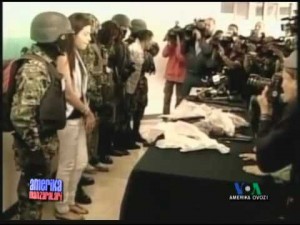 Mexican teenage girls train as drug cartel killers
Mexican teenage girls train as drug cartel killers
MEXICO CITY (Reuters) – Dwarfed by surrounding reporters and with her head bowed to avoid the television cameras, the slender 16-year-old hesitated slightly before she answered the question. “I’m a hitwoman,” she said.
Maria Celeste Mendoza was among six teenage suspected gang members arrested this week by police after a shoot-out with authorities in central Mexico, one of the growing ranks of young people working for the country’s drug cartels.
Dressed in combat fatigues and with her face hidden, the girl from the northern border state of Tamaulipas described how she had been trained to use Kalashnikov assault rifles and other weapons by the Zetas, one of Mexico’s most brutal gangs.
In a listless drawl, Mendoza said she was paid 12,000 pesos ($1,000) for two weeks’ work, more than three times the national average. Although she said she was trained as a hitwoman, it was unclear if she had killed anyone yet.
As is customary in Mexico, she and the other suspects, six of whom were women aged 21 or below, were paraded in front of the media by police after their capture in San Cristobal de la Barranca, near the country’s second city, Guadalajara.
Rising youth unemployment, easy access to drugs and the quick cash cartels offer recruits are all blamed for felling
the delinquency that has cast a shadow over Mexico’s future.
“Organized crime has become a job provider for a section of the population who don’t have a lot of other options,” said Victor Clark-Alfaro, director of the Binational Center for Human Rights in Tijuana on the Mexican border with California.
“Since 2000, the age at which people start getting mixed up in organized crime has fallen,” he added. “And in the last few years, the age has dropped to about 17 or 18.”
Detailed figures on the role of minors in the cartels are scarce, but newspaper Reforma said the number charged with involvement in organized crime jumped to 214 last year from 8 in 2007, citing data from the attorney general’s office.
The arrest of Mendoza and another 16-year-old girl with her, Isela Sandoval, is part of the trend. Sandoval also said she had been trained as a hitwoman but that she had not killed anyone yet, according to Mexican media reports.
Around 40,000 people have died in escalating drug-related violence since President Felipe Calderon sent in the army to try to crush the cartels at the end of 2006.
LIVE FAST, DIE YOUNG
Although authorities have arrested a number of teenage hitmen in the past few years, it is highly unusual for women to work as killers for drug gangs, said Clark-Alfaro.
“This may just be an isolated case. But it may mean a new pattern is emerging in the world of organized crime,” he said.
Last December, Mexican soldiers captured suspected drug gang hitman Edgar Jimenez, known as “El Ponchis,” a 14-year-old U.S. citizen who the army said had admitted killing several people while under the influence of drugs.
The vast quantities of narcotics moving across the country toward the lucrative markets of Europe and the United States have helped to turn Mexicans onto drugs earlier than before.
“Kids are starting to take drugs younger and younger,” said Alberto Islas, a security expert at consultancy Risk Evaluation. “A decade ago, the average age was 14, now it’s 10. This has the effect of lowering their perception of risks.”
Coupled with the fact that youth unemployment is now double what it was ten years ago — in a country whose growing population is one of the youngest in the Americas — the trends present the cartels with a rich source of cheap labor.
“Young folk are recruited because they’re potentially more aggressive and less likely to care about the consequences than adults. They’ll take more risks,” said Clark-Alfaro.
He said it is often a short career with the attorney general’s office calculating that young men who get mixed up in organized crime will, on average, be dead within three or four years.
The Network for the Rights of Children in Mexico (REDIM), an advocacy group, says some 30,000 children are believed to work for criminal gangs in Latin America’s No.2 economy, where delinquency is often blamed on high drop-out rates at school.
But even those who remain in the classroom are far from safe from the allure of drugs, guns and crime.
A 2009 government survey of some 55,000 secondary schoolchildren in five Mexican cities showed more than one in five had seen classmates carry a weapon and that one in eight would sell marijuana for cash if a friend egged them on.
Those who graduate toward the cartels can expect a brutal schooling from their new teachers, according to the testimony of Miguel Ortiz Miranda, a member of La Familia cartel captured last year, whose interrogation later surfaced on Youtube.
In graphic detail, he calmly described how new assassins were quickly put to the test with selected victims.
“We made (the new ones) kill them, and slit their throats and quarter them and all that. So that the new people would lose their fear of cutting an arm … or a leg,” he said.
Others end up as drug dealers, fixers or watchmen but those safer jobs do not always pay as well, according to Beatriz Hernandez, 21, one of the other women arrested with Mendoza, who said she earned 4,000 pesos every two weeks as a look-out.
With Mexico struggling to clean up its justice system or create more decent jobs, some young people see gangland murders as a real career option.
“This is about the impunity here,” Islas said. “Because of it, the perception of risk attached to committing this kind of crime is very low. Murders are not solved in Mexico.”